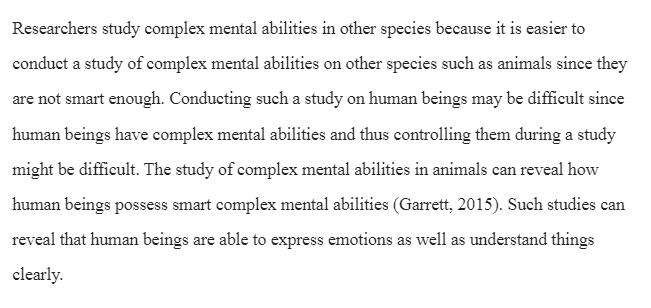Animal Studies of Complex Mental Abilities
Some behavioral researchers study the complex mental abilities of other species. For example, chimpanzees’ language capacity has been the subject of intense scientific scrutiny (and debate) for decades. Other topics in animal research include counting, tool use, and problem solving. Why do researchers study these abilities in other species? Can such studies reveal anything of importance about complex mental abilities in humans? And if researchers use animals in research, what ethical or moral obligations do they have toward the animals?
To prepare for this Discussion:
Review the assigned chapters in Brain and Behavior, paying special attention to the discussion of research of complex mental abilities using animals and the rationale(s) given for such studies.
Think about whether or not you believe that animals actually have an awareness of their actions, given what you have read.
Consider the ethics involved in such animal research. What do you see as its value? Are there good reasons for conducting such research? How would you justify it?
With these thoughts in mind:
Post by Day 4 your thoughts about whether or not animals have an awareness of their actions as humans do, based on the information on animal thought, language, and intelligence. Explain and justify your answer. Then weigh in on the value and ethics of conducting animal research on complex mental abilities. Again, explain and justify your responses.
Be sure to support your postings and responses with specific references to the Learning Resources.
Read a selection of your colleagues’ postings.
Respond by Day 6 to at least one of your colleagues’ postings in one or more of the following ways:
Ask a probing question.
Share an insight from having read your colleague’s posting.
Offer and support an opinion.
Validate an idea with your own experience.
Make a suggestion.
Expand on your colleague’s posting.
Resources to use:
Learning Resources
Please read and view (where applicable) the following Learning Resources before you complete this week’s assignments.
Readings
Course Text: Garrett, B. (2015). Brain and Behavior: An Introduction to Biological Psychology, (4th ed.). Los Angeles: Sage.
Chapter 9, “Hearing and Language” (pp. 265-301)
Chapter 12, “Learning and Memory” (pp. 373-401)
Chapter 13, “Intelligence and Cognitive Functioning” (pp. 403-437)
Web Sites
The Wernicke-Geschwind Model of Language (Brain and Behavior, Figure 9.23)
http://www.sagepub.com/garrettbb2study/animations/9.23.htm
This sequence demonstrates the Wernicke-Geschwind model of language, tracing the routes by which language is processed in different modalities (e.g., spoken, written).
Associative Long-Term Potentiation (Brain and Behavior, Figure 12.10)
http://www.sagepub.com/garrettbb2study/animations/12.10.htm
This sequence demonstrates the neural basis of associative long-term potentiation.
Glutamate’s Role in Long-Term Potentiation (Brain and Behavior, Figure 12.11)
http://www.sagepub.com/garrettbb2study/animations/12.11.htm
This sequence shows how long-term potentiation occurs as a result of changes in synaptic activity.
Answer Preview-Animal Studies of Complex Mental Abilities

